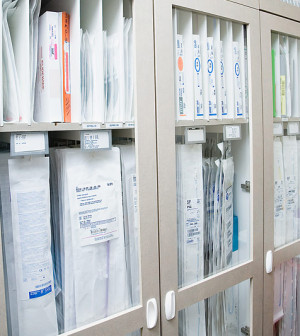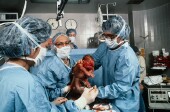- FDA Approves New Antibiotic Against UTIs
- New School Lunch Rules Target Added Sugars, Salt
- Dairy Cows Moved Across State Lines Must Now Be Tested for Bird Flu
- TikTok Riddled With Misleading Info on Health: Study
- Emulsifier Chemicals Are Everywhere in Foods. Could They Raise Diabetes Risk?
- Opioids During Pregnancy May Not Raise Psychiatric Risks for Offspring
- Could Heartburn Meds Raise Your Migraine Risk?
- Drug, Alcohol Abuse Goes Untreated in Many Ex-Prisoners
- Watchdog Group Says U.S. Food Recalls Rose Again Last Year
- Genes Could Mix With Pesticide Exposure to Raise Parkinson’s Risk
Severe Blood Infections During Childbirth on Rise in U.S. Women


THURSDAY, Sept. 26In a disturbing trend, rates of severe sepsis and deaths from sepsis during childbirth rose sharply in the United States over a 10-year period, a new study reveals.
The researchers said their findings show the need for improved detection of sepsis in all women during labor and delivery, even those with no apparent risk factors for sepsis, a severe illness in which bacteria overwhelm the bloodstream.
For the study, Dr. Melissa Bauer, of the University of Michigan Health System in Ann Arbor, and colleagues analyzed national data from 1998 through 2008 and found that, overall, sepsis occurred at a rate of one per every 3,333 women who were in a hospital to give birth. The rate did not change significantly over the study period.
Severe sepsis — which can lead to multiple organ failure — occurred in about one in 11,000 women. The rate of severe sepsis approximately doubled from 1998 to 2008: from about one in 15,400 to one in 7,250 women in labor.
Fatal sepsis occurred in about one in 106,000 cases. Both severe and fatal sepsis increased by about 10 percent per year, found the study in the October issue of the journal Anesthesia & Analgesia.
Several medical conditions were associated with an increased risk of severe sepsis, including congestive heart failure, chronic liver and kidney disease, and lupus. Cerclage, or “cervical stitch” — which is done to prevent premature birth — was another significant risk factor, according to a journal news release.
Similar to risk factors for other complications of labor and delivery, other factors associated with an increased risk of severe sepsis included older age, being black, and having Medicaid insurance.
But none of these factors explained more than 6 percent of the sepsis cases. Many women who developed severe or fatal sepsis during labor and delivery had no known risk factors, according to Bauer’s team.
The data did not reveal what might be causing the sharp increase in severe and fatal sepsis during labor and delivery, but it may be due to factors “such as increasing microbial resistance, obesity, smoking, substance abuse and poor general health,” the study authors wrote.
The finding that many cases of severe and fatal sepsis occur in women with no apparent risk factors “underscores the need for developing systems of care that increase sensitivity for disease detection across the entire population,” the researchers concluded.
More information
The U.S. National Library of Medicine has more about sepsis.
Source: HealthDay
Copyright © 2024 HealthDay. All rights reserved.










